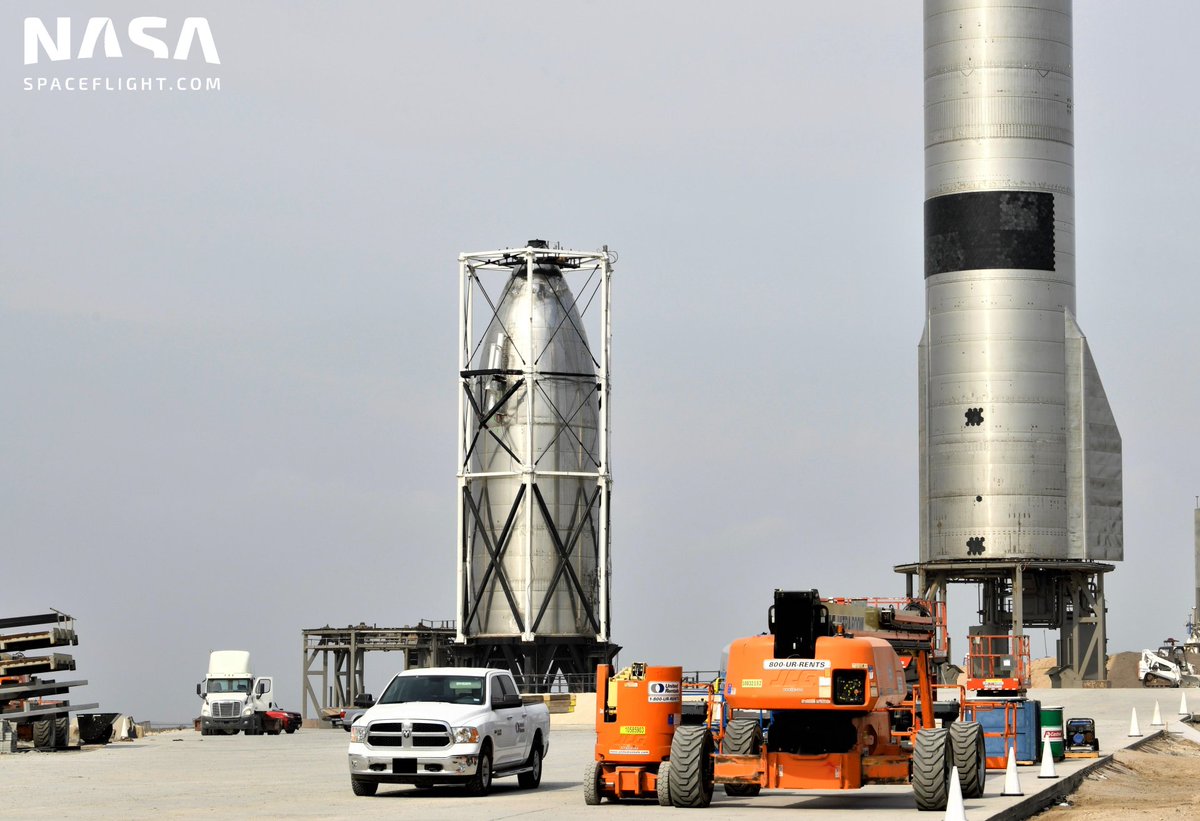Ship 29 is the newest oddity at the Production Site, but we may know what's happening this time around. Let's take a look at this new article that SpaceX is producing, and why we believe it may be a Structural Test Article. (1/13)
📸 @ChameleonCir
📸 @ChameleonCir

@ChameleonCir Starting off looking at S29's nosecone, we can see some TPS pins on the side. This is likely because S29 was intended to be a normal Ship. With the cone now outside of the tent and having other work done, the pins will likely not be finished. (2/13)
📸 @nomadd13
📸 @nomadd13
@ChameleonCir @nomadd13 Well then, it's probably just another S26, right? That was a possibility until SpaceX began properly developing the flap mounting surfaces. This typically happens after tiling, and if this nose has no tiles, it would burn up before needing flaps. (3/13)
📸 @RGVaerialphotos
📸 @RGVaerialphotos
@ChameleonCir @nomadd13 @RGVaerialphotos A nosecone test article would need these mounting points though, because flap simulators are installed for the structural testing. (4/13)
📸 @BocaChicaGal
📸 @BocaChicaGal

@ChameleonCir @nomadd13 @RGVaerialphotos @BocaChicaGal If this is for a test article, we expect that the tip of the nosecone would be removed, similar to what happened to SN12's nosecone nearly two years ago. This is yet to happen, but we anticipate that it will soon enough. (5/13)
📸 @BocaChicaGal @RGVaerialphotos
📸 @BocaChicaGal @RGVaerialphotos
@ChameleonCir @nomadd13 @RGVaerialphotos @BocaChicaGal Now, let's move down to the Payload Bay. It had a fairly normal trip through the production process until SpaceX installed only a stripped-down base portion of the dispenser. (6/13)
📸 @NicAnsuini
📸 @NicAnsuini
@ChameleonCir @nomadd13 @RGVaerialphotos @BocaChicaGal @NicAnsuini This piece did not have the expected electrical parts and systems that a working PEZ dispenser has. Typically a PEZ dispenser is installed as one unit, with all of the hardware preinstalled. (7/13)
📸 @StarshipGazer @NicAnsuini
📸 @StarshipGazer @NicAnsuini

@ChameleonCir @nomadd13 @RGVaerialphotos @BocaChicaGal @NicAnsuini @StarshipGazer Typically TPS pins application occurs before PEZ dispenser processing. The only time it didn't was with S26, and we know how that went. So this is consistent with the nosecone having no heatshield. (8/13)
📸 @chrisk_91
📸 @chrisk_91

@ChameleonCir @nomadd13 @RGVaerialphotos @BocaChicaGal @NicAnsuini @StarshipGazer @chrisk_91 The various aft sections are also suggesting something weird. Inside Tent 2, we are able to see S27's aft in the back, and S28's aft just in front based on what we have tracked. The 3rd aft section in front should be S29, but…. those are TPS pins. (9/13)
📸 @RGVaerialphotos
📸 @RGVaerialphotos
@ChameleonCir @nomadd13 @RGVaerialphotos @BocaChicaGal @NicAnsuini @StarshipGazer @chrisk_91 This is a brand new aft section, one that should have been pinned after S29 was evidently decided to not have tiles. With this in mind, we believe that it may be for S30, leaving S29’s aft missing. (10/13)
@ChameleonCir @nomadd13 @RGVaerialphotos @BocaChicaGal @NicAnsuini @StarshipGazer @chrisk_91 If you haven't checked it out yet, we have a Discord server where all of our tracking happens. We also have a bot that shows what's been spotted for the various Ships. Taking a look at S29, the parts seem to be limited to the top half. (11/13)
discord.gg/wbz2MssN6Q
discord.gg/wbz2MssN6Q

@ChameleonCir @nomadd13 @RGVaerialphotos @BocaChicaGal @NicAnsuini @StarshipGazer @chrisk_91 Various parts of the Nosecone Testing Cage have been seeing work recently as well. The base has begun being reassembled, and the black tip that goes on the Nosecone has been moved near the base. (12/13)
📸 @RGVaerialphotos
📸 @RGVaerialphotos
@ChameleonCir @nomadd13 @RGVaerialphotos @BocaChicaGal @NicAnsuini @StarshipGazer @chrisk_91 All of this suggests that S29 may be an article used to verify the design of Starship's upper half during flight, like what was done with SN12’s nosecone last year. Hopefully, we'll get to see this put together soon and, more importantly, pass testing. (13/13)
📸 @BocaChicaGal
📸 @BocaChicaGal

• • •
Missing some Tweet in this thread? You can try to
force a refresh










